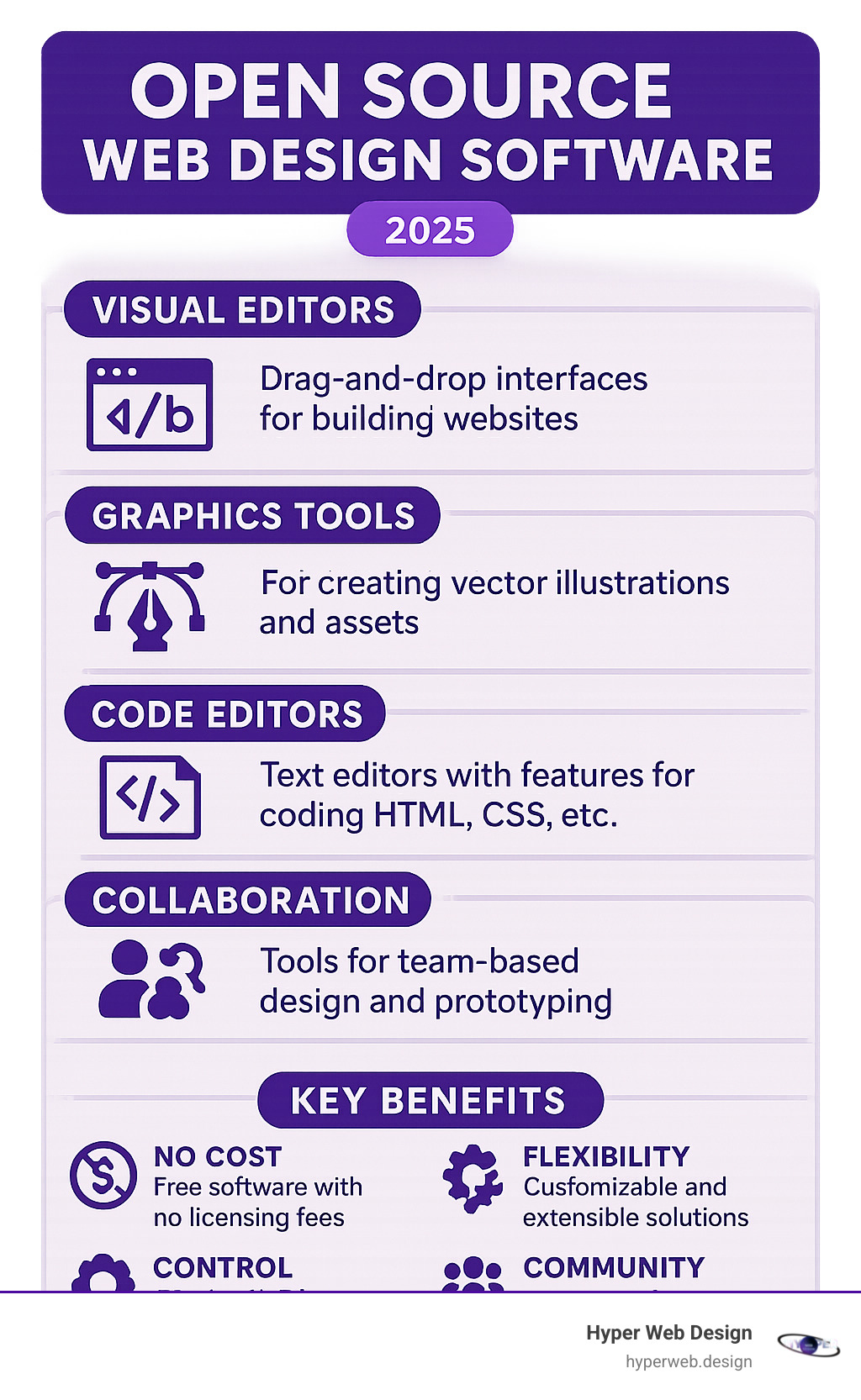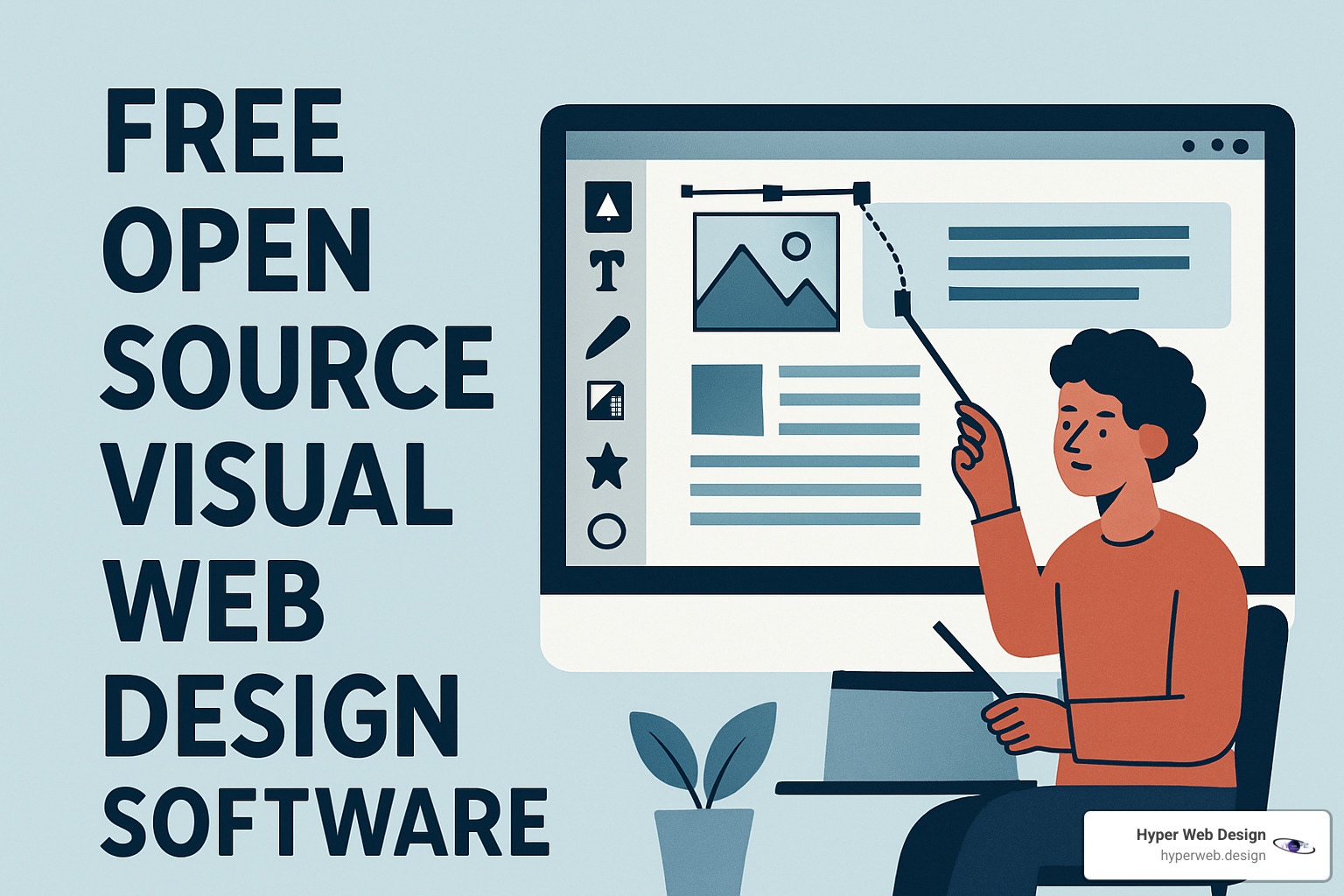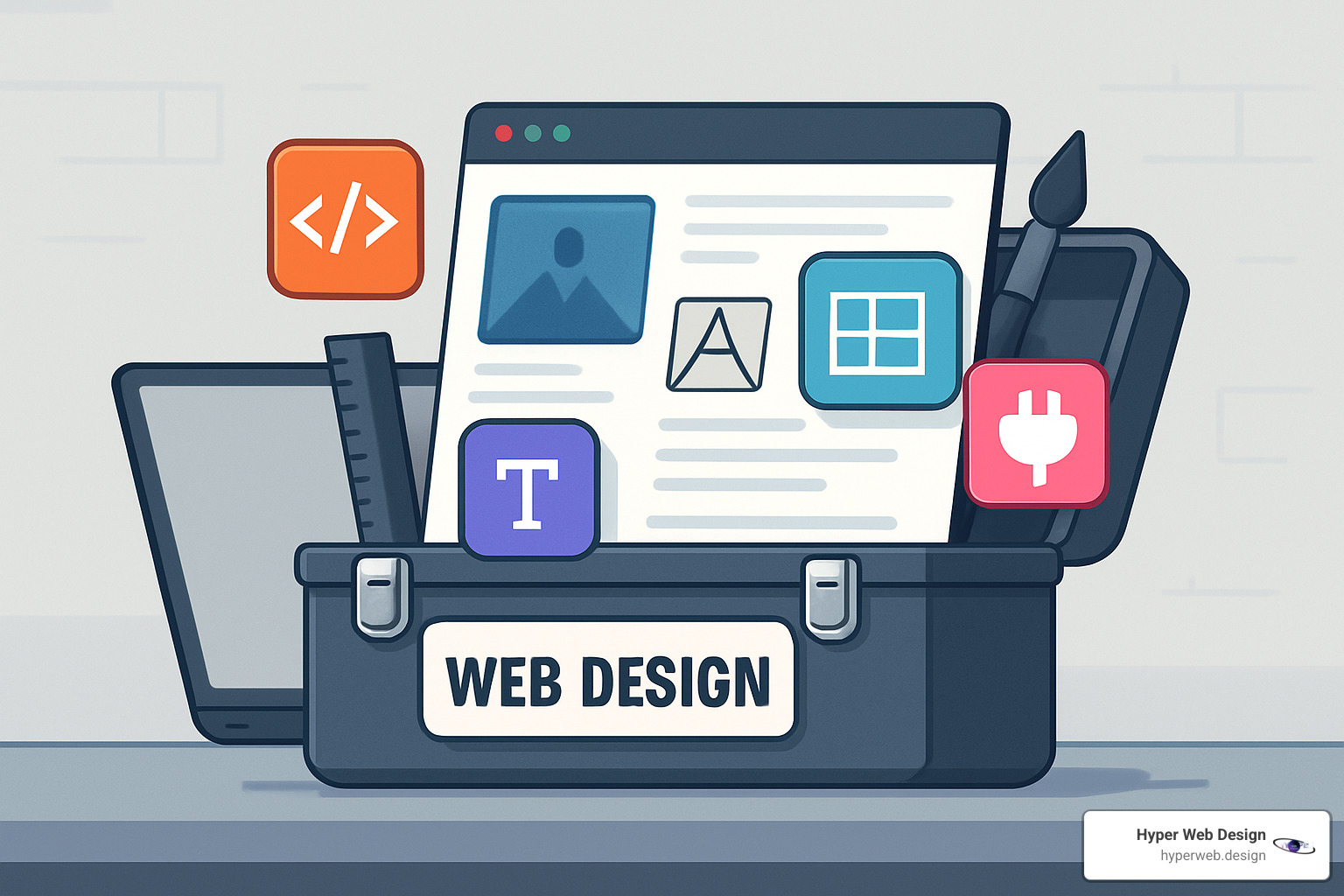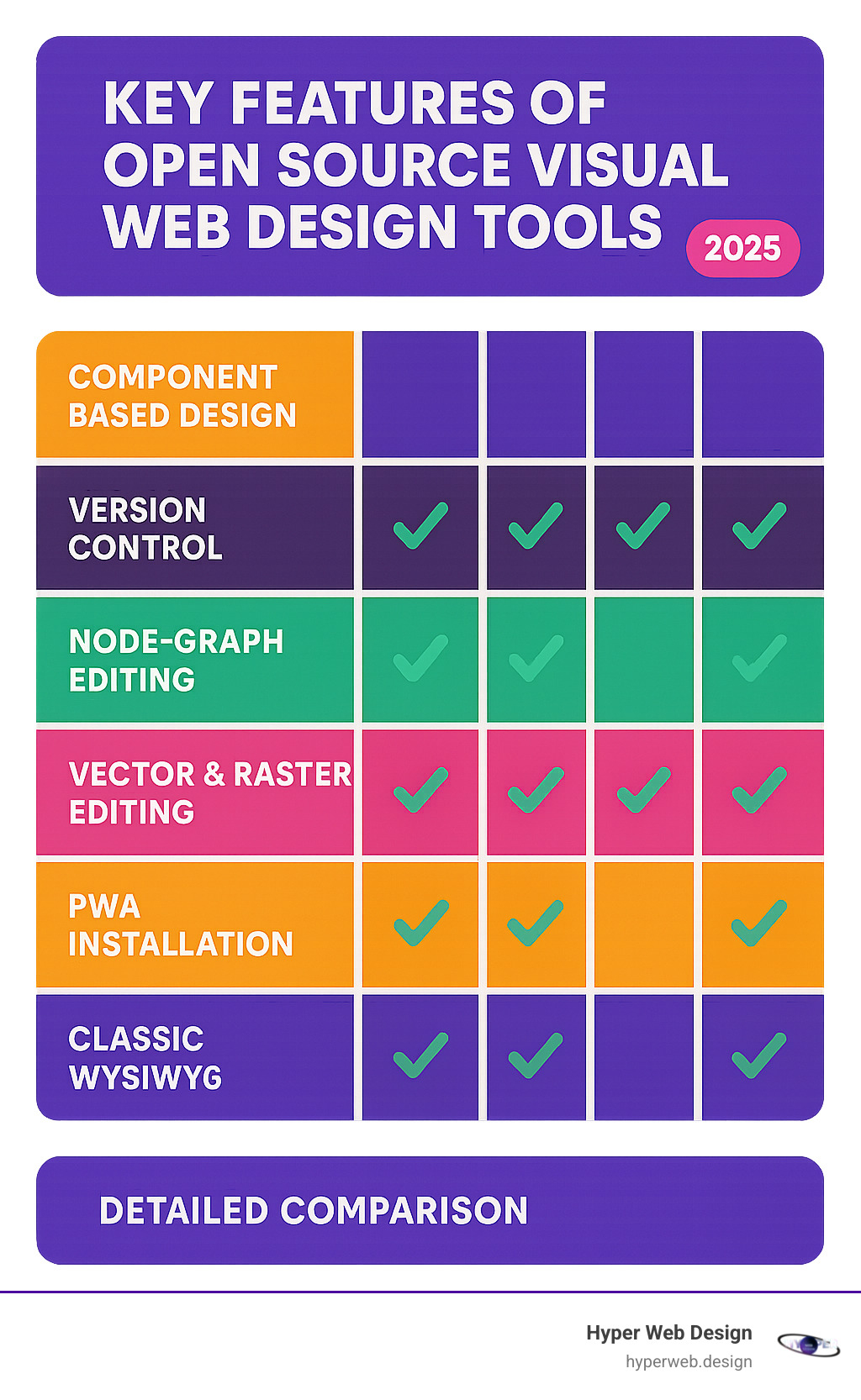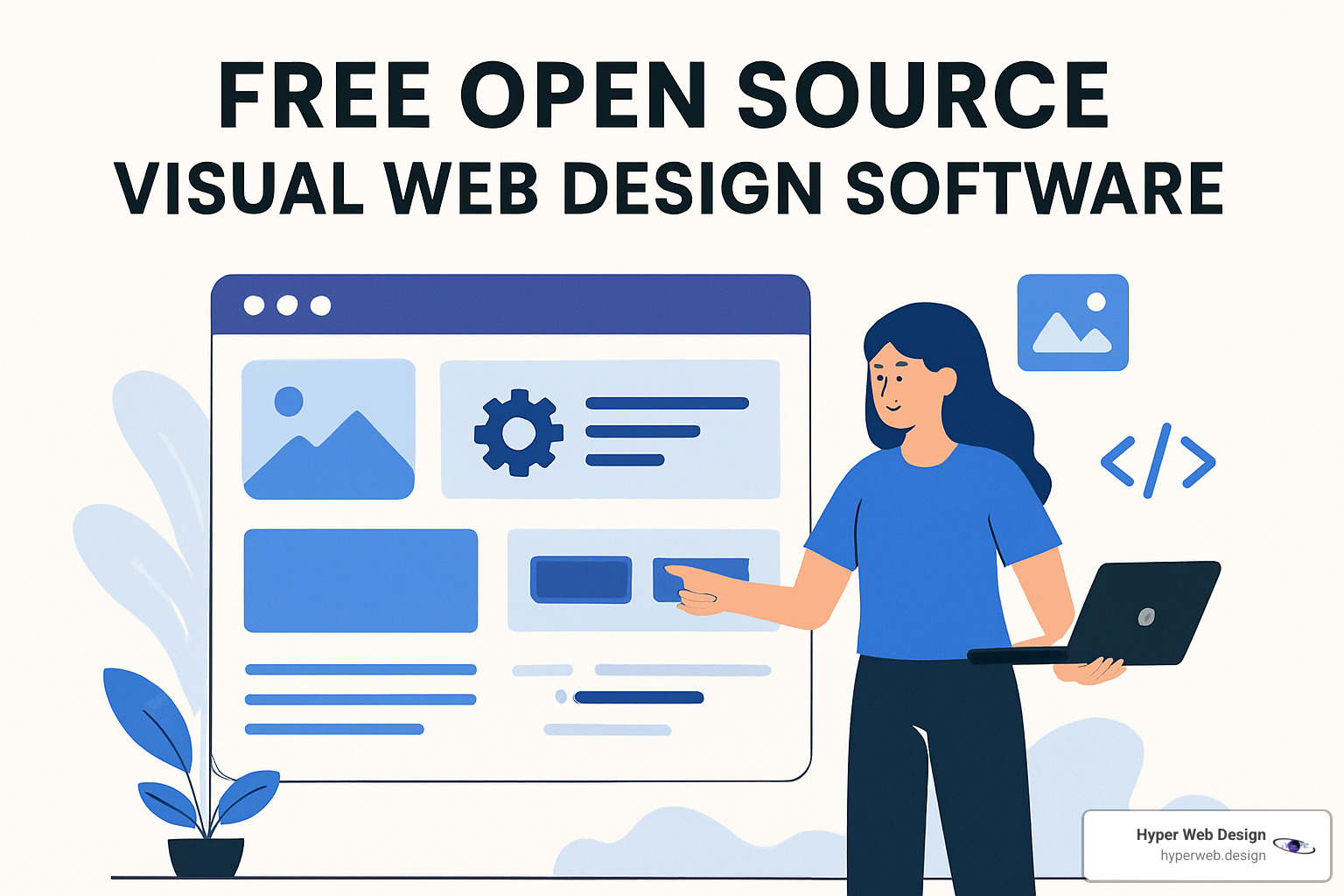Why Free Open Source Visual Web Design Software is Revolutionizing Web Design
Free open source visual web design software offers powerful alternatives to expensive proprietary tools, giving designers and developers complete control over their creative process without monthly subscription fees or vendor lock-in.
These tools combine visual editing capabilities with open source flexibility, allowing you to create professional websites without the constraints of proprietary software. Most support modern web standards, responsive design, and collaborative workflows that rival expensive commercial alternatives.
The shift toward open source design tools reflects a broader industry trend – with 94% of first impressions being design-related and nearly 60% of web traffic coming from mobile devices, designers need flexible, cost-effective solutions that don’t compromise on quality or features.
I’m Shawn Shameli, and over the past decade working with web design and development, I’ve seen free open source visual web design software evolve from basic editors to sophisticated platforms that rival premium tools. My experience has shown that these open source solutions often provide better long-term value and flexibility for both individual designers and enterprise teams.
Why Choose Free Open Source Visual Web Design Software?
When you’re exploring free open source visual web design software, you’re stepping into a completely different philosophy of how software should work – one that puts you, the designer, firmly in control.
Most proprietary design tools are like renting an apartment. You pay monthly, follow the landlord’s rules, and when you stop paying, you lose access to everything. Open source tools are like owning your own home. You have the keys, you can renovate however you want, and nobody can kick you out.
The community-driven development behind these tools creates something magical. Instead of a small team of developers guessing what designers need, you have thousands of actual users contributing ideas, reporting bugs, and building features. This means the software evolves based on real-world needs, not corporate boardroom decisions.
Transparency might sound like a technical buzzword, but it’s actually quite practical. When you can see exactly how the software works, you can trust it with your most important projects. No hidden data collection, no mysterious algorithms deciding how your designs should look, no surprise changes that break your workflow.
The no vendor lock-in aspect is where open source really shines. We’ve all heard horror stories about designers losing years of work when a company changes its pricing or shuts down entirely. Open source tools typically use standard file formats and provide easy export options, so your work stays yours forever.
Rapid iteration happens naturally in open source environments. When a developer in Berlin fixes a bug at midnight, a designer in Tokyo can benefit from that fix the next morning. This speed of improvement often leaves proprietary tools struggling to keep up.
For SEO-friendliness and standards compliance, open source tools have a distinct advantage. Since the code is open for review, these tools tend to generate cleaner, more semantic HTML. According to Scientific research on responsiveness, mobile traffic dominates the web, and open source visual design tools have been particularly quick to adapt to mobile-first design principles.
Main Benefits for Designers & Developers
Ownership changes everything about how you work. With open source tools, you’re not just using software – you’re becoming part of an ecosystem. Your customizations, your workflows, even your feature requests become part of your permanent toolkit.
Flexibility reaches levels that proprietary tools simply can’t match. Need a specific integration with your client’s unusual CMS? Want to automate a repetitive design task? The open architecture means you can build exactly what you need, not just work within someone else’s limitations.
How Open Source Differs From Proprietary Editors
License freedom means you can use these tools however you want. No restrictions on commercial use, no limits on team size, no sudden price increases that blow up your budget. You’re free to focus on creating great designs instead of managing software licenses.
Self-hosting gives you complete control over your design environment. Instead of wondering if the cloud service will be down when you have a deadline, you can run everything on your own servers. This is especially valuable when working with sensitive client data or when you need guaranteed uptime.
Extensibility is perhaps the most powerful difference. While proprietary tools limit you to their vision of what a designer needs, open source alternatives can grow with you. As your skills develop and your projects become more complex, your tools can evolve alongside your expertise.
Top Features of Free Open Source Visual Web Design Software
When you dive into free open source visual web design software, you’ll find feature sets that honestly surprised me when I first started exploring them. These tools have quietly evolved into sophisticated platforms that rival expensive commercial software – and in many cases, they’re actually better.
The visual editing capabilities have reached a level where you can achieve pixel-perfect designs without touching a single line of code. I’ve watched designers create complex layouts with advanced typography and sophisticated spacing systems, all through intuitive drag-and-drop interfaces.
Code export functionality is where these tools really shine. They generate clean, standards-compliant HTML and CSS that actually makes developers happy. I’ve seen exported code that’s cleaner than what many experienced developers write by hand, with proper semantic structure and optimized performance built right in.
The responsive controls address our mobile-first reality head-on. With mobile traffic dominating the web, these tools offer sophisticated breakpoint management and device-specific design variations. Some even provide automated responsive behavior that adapts your designs intelligently across different screen sizes.
Template libraries benefit from something proprietary tools can’t match – genuine community contributions. Instead of corporate-designed templates, you get starting points created by real designers solving real problems.
Visual Editing & Collaboration
The vector editing capabilities in modern open source tools genuinely compete with dedicated graphics software. You can handle advanced path editing, boolean operations, and even procedural graphics generation. This means fewer tools in your workflow and more time actually designing.
Real-time collaboration has become standard, with multiple team members working on the same project simultaneously. The implementation often feels more robust than proprietary alternatives because it’s built on open standards rather than locked-down proprietary systems.
Design tokens represent a game-changing advancement in design system management. You define colors, typography, spacing, and other design elements once, then apply them consistently across your entire project. When you need to make changes, updating the token automatically updates every instance throughout your design.
No-Code & Low-Code Capabilities
The drag-and-drop interfaces have become incredibly sophisticated while remaining genuinely intuitive. Non-technical users can create complex layouts and interactions, while professionals still get the precision they need for detailed work.
Static site generation capabilities mean you can create fast, SEO-friendly websites without complex server infrastructure. This approach has gained popularity due to its performance benefits and security advantages.
Headless CMS integration allows you to separate content management from design, giving you flexibility in how you structure and manage website content. This is particularly valuable for sites that need to serve content across multiple channels or platforms.
Embeddable & Extensible Editors
Framework SDK capabilities allow developers to integrate visual editing directly into their applications. This means you can offer clients the ability to edit their websites visually without them needing to learn separate software – a huge advantage for ongoing client relationships.
JSON export functionality ensures your designs integrate easily into various development workflows. This standardized format makes it simple to process designs programmatically or integrate with other tools and services.
White-label options allow agencies to customize the interface and branding of the design tools themselves. This creates a more cohesive experience for clients and can be a significant differentiator in the marketplace.
Get Started for Free with Open Source Tools – We can help you evaluate and implement the best open source design tools for your specific needs.
Modern Alternatives to Proprietary Solutions
Visual CSS editing has reached new levels of sophistication, with tools offering direct manipulation of CSS properties through intuitive interfaces. You can work visually while maintaining full control over the underlying code – the best of both worlds.
Global design tokens provide a systematic approach to maintaining consistency across large projects. You define design standards once and apply them consistently throughout your project, making updates and maintenance much more manageable.
Component-Based & Modular Design
No-code components represent a significant evolution in web design thinking. Instead of starting from scratch every time, you build reusable components that maintain consistency while allowing for customization.
Design tokens at the component level allow for sophisticated theming and customization options. You can create components that automatically adapt to different brand guidelines or design systems – incredibly powerful for agencies managing multiple client brands.
Graphics & Asset Management
Node-graph editing brings procedural design capabilities to web design tools. This approach allows for non-destructive editing and the creation of complex graphics that can be easily modified and refined.
Vector and raster editing capabilities mean you don’t need separate graphics software for many tasks. These integrated tools can handle everything from simple icon creation to complex illustrations, keeping your workflow streamlined.
Asset management systems help organize and optimize the various files and resources used in web projects. These systems often include automatic optimization features that improve website performance without any extra effort on your part.
See a Demo of Open Source Graphics Editing – Experience how these tools can transform your design workflow.
Classic WYSIWYG Editing
Cross-platform compatibility ensures these tools work consistently across different operating systems and devices. This is particularly important for teams working with diverse technology stacks.
Integrated FTP capabilities allow for direct publishing to web servers, eliminating the need for separate file transfer tools. This streamlines the workflow from design to deployment in a way that feels natural and efficient.
Key Features to Evaluate in a Visual Web Design Tool
Choosing the right free open source visual web design software can feel overwhelming with so many options available. After years of testing different tools and seeing what works in real projects, I’ve learned that certain features make the difference between a tool that helps you create amazing websites and one that holds you back.
The most important feature to look for is responsive breakpoints. In today’s world where mobile devices account for over 60% of web traffic, your design tool needs to handle different screen sizes effortlessly. The best tools let you see exactly how your design will look on phones, tablets, and desktops without guessing or hoping for the best.
Drag-and-drop functionality should feel natural and intuitive. You shouldn’t have to fight with the interface to place elements where you want them. Good tools provide helpful guides that snap elements into place and make alignment easy.
Code export quality is where many free tools stumble, but the best ones excel. The HTML and CSS your tool generates should be clean, fast-loading, and follow web standards. Poor code export can hurt your SEO rankings and make future updates difficult.
Accessibility features aren’t just nice to have anymore – they’re essential. With over 1.3 billion people worldwide living with disabilities, your design tool should help you create websites everyone can use. Look for features that check color contrast, manage heading structures, and handle alt text for images.
SEO settings should be built into your design process, not added as an afterthought. The tool should make it easy to set up proper meta tags, heading hierarchies, and other elements that search engines care about.
Asset management capabilities help keep your projects organized and your websites fast. Good tools optimize images automatically, organize files logically, and help you avoid the chaos of scattered design assets.
More info about responsive design – Learn how responsive design principles can improve your website’s performance across all devices.
Support for Responsive & Mobile-First Design
Fluid grid systems form the backbone of modern responsive design. The best tools make these grids feel natural to work with, automatically adjusting your layout for different screen sizes while maintaining your design’s integrity.
Device previews should show you exactly how your design will look on real devices. Some tools even simulate different internet speeds, which is incredibly helpful since not everyone has blazing-fast connections.
Media queries might sound technical, but good tools make them visual and intuitive. You should be able to create device-specific design variations through simple visual controls, not by writing complicated CSS code.
Building Dynamic, Data-Driven Sites
CMS connectors open up possibilities for creating websites that update themselves. Instead of manually updating content, you can connect to popular content management systems and let your site pull in fresh content automatically.
API fetch capabilities let your static designs come alive with real-time data. Whether you’re displaying weather information, social media feeds, or product catalogs, these features help you create dynamic experiences without complex backend development.
Headless architecture support represents the future of web development. This approach separates your content management from your design, giving you more flexibility and better performance.
Collaboration & Workflow Integration
Real-time editing becomes crucial when working with teams. Multiple people should be able to work on the same project without stepping on each other’s toes. The best tools show you who’s working on what and handle conflicts gracefully when they arise.
Version history acts like a safety net for your projects. You can see how designs evolved over time and easily revert to previous versions if something goes wrong.
Developer handoff features bridge the gap between design and development. Instead of lengthy explanation emails, good tools provide detailed specifications, asset exports, and code snippets that make implementation straightforward.
Getting Started & Best Practices
Starting your journey with free open source visual web design software doesn’t have to feel overwhelming. Think of it like learning to cook – you don’t need to master every technique on day one, but understanding the basics will set you up for success.
The beauty of open source tools is that they meet you where you are. Some tools run directly in your web browser, so you can start designing immediately without downloading anything. Others are desktop applications that give you more power and control.
Installation options really depend on what you’re comfortable with. Browser-based tools are perfect for beginners or anyone who wants to jump in quickly. Desktop applications usually offer more features and better performance. Self-hosted solutions give you complete control but require more technical know-how.
When deciding between self-hosting versus cloud hosting, consider your priorities. Cloud hosting is like staying at a hotel – everything’s taken care of, but you have less control. Self-hosting is like owning your own home – more responsibility, but you can customize everything exactly how you want it.
The learning curve varies dramatically between tools. Some are designed with beginners in mind, offering step-by-step tutorials and helpful tooltips. Others assume you already know the basics of web design. Choose something that matches your current skill level, but don’t be afraid to challenge yourself a little.
Security considerations are important with any software, but open source tools have a unique advantage. Because the code is public, security experts around the world can review it and spot potential problems. Just remember to keep your tools updated and follow basic security practices.
More info about SEO optimized websites – Find how proper SEO implementation from the design phase can dramatically improve your website’s search engine performance.
Beginner Roadmap with Free Open Source Visual Web Design Software
Tool selection should feel like choosing the right tool for a job, not picking a lifetime partner. Start with something that has good documentation and an active community. You can always switch later as your skills and needs evolve.
The tutorial ecosystem around open source tools is usually fantastic. Look for official documentation first, then explore community-created tutorials and video guides. The best approach combines structured learning with hands-on experimentation.
Community support is where open source really shines. Most tools have friendly forums, chat channels, and social media groups where experienced users help newcomers. Don’t be shy about asking questions – everyone was a beginner once, and the community generally loves helping people succeed.
Sandbox projects are your friend. Start with simple, low-pressure projects where you can experiment freely. Maybe redesign your personal website or create a landing page for a hobby project. This gives you room to make mistakes and learn without stress.
Extending & Customizing Your Chosen Tool
Plugin ecosystems can transform a basic tool into a powerhouse. Some tools have hundreds of plugins available, while others are more limited. Think of plugins like apps on your phone – they add specific features that make your life easier.
Custom components become important as you grow more sophisticated. You might find yourself creating the same design elements repeatedly. Most tools let you save these as reusable components, which saves time and ensures consistency across your projects.
Theme creation allows you to customize the look and feel of your design tools themselves. This is particularly valuable if you’re working with clients and want to maintain consistent branding throughout your workflow.
Contribution guidelines explain how you can give back to the community that’s supporting your work. Contributing doesn’t always mean writing code – you can help with documentation, report bugs, suggest features, or even provide financial support.
Frequently Asked Questions about Free Open Source Visual Web Design Software
What’s the easiest tool for absolute beginners?
If you’re just starting out, I always recommend beginning with browser-based tools that don’t require any complicated installation process. You can literally open your web browser and start designing right away. The best beginner-friendly options focus on drag-and-drop interfaces combined with solid documentation and helpful community forums.
What makes a tool truly beginner-friendly is when it shows you both the visual design and the underlying code. This dual approach helps you understand how your design choices translate into actual HTML and CSS, which is incredibly valuable for learning.
Look for tools that offer pre-built templates and components. These give you a solid starting point and help you understand how professional websites are structured. The active community support around these tools means you’ll never feel stuck for long.
Can I achieve good SEO without coding skills?
This is one of my favorite questions because the answer is a resounding yes! Modern free open source visual web design software has really stepped up its game when it comes to SEO-friendly features that work without any coding knowledge.
The secret is that these tools now generate clean, semantic HTML automatically. They handle the technical SEO foundations while giving you simple interfaces to manage the important stuff like meta descriptions, page titles, and image alt text. It’s like having an SEO expert built right into your design tool.
Many tools now include SEO checklists that guide you through the optimization process step by step. They’ll remind you to add meta tags, check your heading structure, and optimize your images. Some even provide real-time feedback on how SEO-friendly your content is as you create it.
How do these tools stay funded if they’re free?
This question comes up a lot, and it’s totally understandable! The funding models for open source projects are actually quite diverse and often more sustainable than you might expect.
Many successful projects operate on a “freemium” model where the core functionality remains completely free, but premium features, professional support, or hosting services are available for a fee. This approach ensures the project can continue developing while keeping the essential tools accessible to everyone.
Some tools are backed by companies that offer commercial services around the open source software. They might provide consulting, custom development, or enterprise-level support. The free tool serves as both a community service and a way to showcase their expertise.
Community funding through donations, grants, and corporate sponsorships also plays a huge role. Many organizations that benefit from these tools contribute financially to ensure their continued development.
The collaborative development model itself reduces costs significantly. Instead of one company bearing all development expenses, the work is distributed across many contributors who volunteer their time and expertise.
Conclusion
The world of web design has reached a turning point, and free open source visual web design software sits right at the center of this change. What started as simple alternatives to expensive proprietary tools has evolved into something much more significant – a complete reimagining of how we approach digital creativity.
These tools aren’t just about saving money, though that’s certainly a welcome benefit. They represent a fundamental shift toward more democratic design practices where creativity isn’t limited by corporate licensing restrictions or subscription fees. The collaborative nature of open source development means these tools often outpace their commercial counterparts in innovation and user-focused features.
Throughout my years working with web design projects, I’ve witnessed this evolution firsthand. The free open source visual web design software available today handles professional projects with ease while offering advantages that proprietary alternatives simply can’t match. The transparency, flexibility, and community support create an environment where both designers and clients benefit.
At Hyper Web Design, we’ve integrated these tools into our workflow not as budget alternatives, but as preferred solutions for many of our Houston-area clients. The ability to customize, extend, and truly own your design tools has proven invaluable for creating the high-end, conversion-focused websites our clients expect.
The future looks incredibly bright for open source design tools. New projects launch regularly, existing tools add sophisticated features at breakneck speed, and the community continues to grow with passionate contributors who understand real-world design challenges.
Whether you’re a freelance designer tired of subscription fees, an agency seeking more flexible solutions, or a business owner wanting complete control over your digital tools, the open source ecosystem has something powerful to offer. The barrier to entry has never been lower, and the potential benefits have never been higher.
Your next step is simple: pick one tool from this guide and start experimenting. Begin with a small project, connect with the community, and experience how these tools can transform your design process. The learning curve might seem daunting at first, but the long-term benefits far outweigh the initial investment of time.
The revolution in web design tools isn’t coming – it’s already here, and it’s open source. By embracing these tools, you’re not just saving money or gaining flexibility. You’re joining a movement toward more accessible, innovative, and sustainable design practices.
More info about Custom Website Design & Development – Find how our team combines open source tools with custom development to create exceptional digital experiences for our clients.
The future of web design is open, collaborative, and incredibly exciting. Jump in and be part of it – your creative potential and your budget will both thank you for making the leap.

